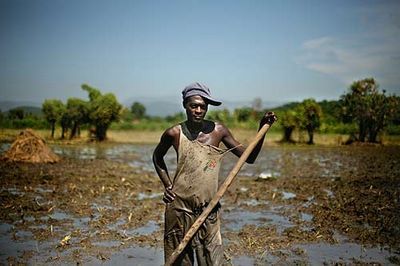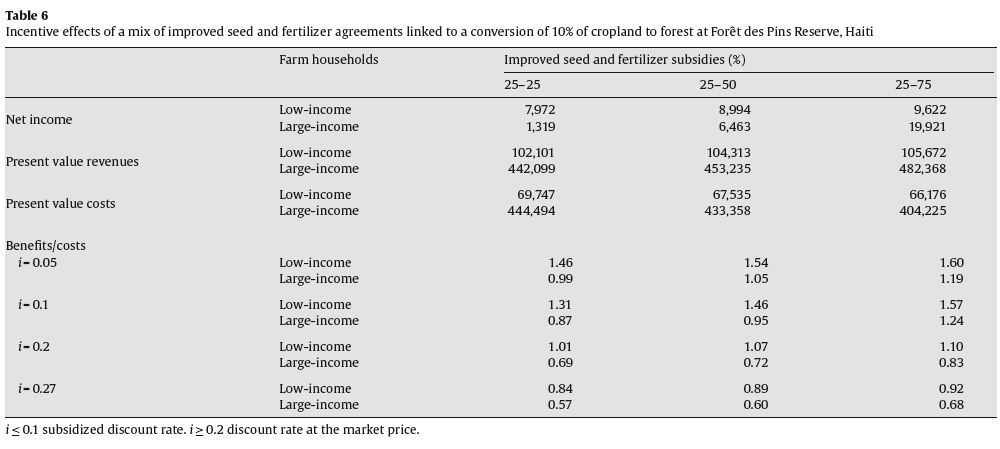 As I wrote yesterday in my piece for The Huffington Post, the history of Western financial involvement in Haiti has been one of growing the nation's textile industry despite the fact that 70% of Haiti's annual income comes from agriculture. By emphasizing programs such as HOPE and HOPE II, the United States has increased the profits of American companies, but the livelihood of Haitian workers has decreased at nearly the same rate.
As I wrote yesterday in my piece for The Huffington Post, the history of Western financial involvement in Haiti has been one of growing the nation's textile industry despite the fact that 70% of Haiti's annual income comes from agriculture. By emphasizing programs such as HOPE and HOPE II, the United States has increased the profits of American companies, but the livelihood of Haitian workers has decreased at nearly the same rate.
[A] 2009 report by the Congressional Research Service found that "assessments of the effectiveness of Hope I, however, were disappointing." Since 2004 Haitian exports to the United States increased by 32% while, during the same period, the Haitian minimum wage declined by 36%. Haiti's current trade imbalance is enormous and the country relies exclusively on foreign sources for basic commodities such as food and oil.
Another critical element has been the role of the World Bank and International Monetary Fund in tying development loans to privatization of the nation's infrastructure and eliminating subsidies to agriculture. As a result, the heavily subsidized American farmers are able to sell their products in Haiti more cheaply than local farmers. One unintended consequence has been that, in order to make ends meet, local farmers have continued to erode Haiti's already decimated forest land. Today it is estimated that Haiti's once lush forests have been reduced to a mere 3% of what they had been when Columbus first arrived on the island. What can be done to reverse this trend while, at the same time, allowing the already impoverished Haitian farmers to improve their conditions?
Frito Dolisca and collegues writing in the journal Land Use Policy suggest that a primary problem has been that, for decades, Haitian governments have taxed farmers for their land use in order to raise much needed revenue.
Government policies only consist of regulations and taxes rather than providing resources and incentives for appropriate land use. Policies aim to eliminate the symptoms of rural decline (such as deforestation, soil erosion) rather than reversing its causes. . . Some governments have adopted laws and regulations to prevent farmers from undertaking degrading activities or to force them to adopt conservation practices. However, such measures are not without costs. Regulation options rely on administrative measures which often exceed government's financial and technical resources, making them questionable policies when evaluated in terms of cost-benefit analyses. Other measures have concentrated on "negative incentives" such as fines to coerce farmers into compliance with best management practices. Again, Haitian governments and farm households cannot effectively guarantee the use of such tools since enforcement of regulatory mechanisms is often costly and inadequate.
It is fair to say that regulation and negative incentives would be of limited use considering that the government of Haiti doesn't have the funds to adequately protect the forests. Therefore, Dolisca and his coauthors suggest that if the Haitian government provided subsidies and incentives to poor farmers to protect the environment, rather than merely punishing farmers for their impact, the current trend could be reversed.
The authors employed a model to simulate the potential effect of different policy approaches on large-income and low-income farms. Based on this approach, the most effective measure was that providing incentives to poor farmers, in the form of agricultural subsidies, offered the best hope for limiting the impact. If farmers were asked to give up 10% of their land for the regrowth of forests and, in exchange, they were granted improved seed and fertilizer subsidies this model suggests that all farmers could increase their annual income.
Although the 25% seed subsidy alone brought a negative net annual income for large-income farm households, combining it with a fertilizer subsidy of 25%, 50%, and 75% raised the net annual income by 122%, 212%, and 446% respectively. At i ⤠0.05, the combination of seed and fertilizer subsidies (25-75) is socially efficient, but the combinations 25-25 and 25-50 scenarios are only marginally so. For low-income farm households, the policy instrument is socially efficient for any combination of seed and fertilizers subsidies at i ⤠0.2.
In other words, by providing a 25% subsidy for seed and a 75% subsidy for fertilizers both large and small farms would improve their income while at the same time improving the conditions of their environment. These subsidies would also be less expensive than the current practice of punishing infractions.
The modeling results indicate that agricultural subsidies tied to forest conservation can provide opportunities for addressing land degradation problems without adversely impacting the welfare of the people. . . The mix of seed and fertilizer policy instrument is recommended since it is costless and seems likely more affordable than the other policies by the Haitian government.
There is a significant problem however. As I pointed out in my article, the World Bank and International Monetary Fund prevent the Haitian government from giving subsidies to their farmers. This has left the Haitian government with no option other than to use the inefficient method of punishment and taxation in order to prevent harm. As world leaders are currently assembled in Davos, Switzerland for the World Economic Forum, it is important for them to reconsider some of the policies that have kept Haiti from using strategies that are in their long term interest. Conservation is essential for the island's sustainability. By employing smart subsidies perhaps the Haitian people can begin to recover after several decades of short-sighted restrictions implemented by international bureaucrats.
![]() DOLISCA, F., MCDANIEL, J., SHANNON, D., & JOLLY, C. (2009). Modeling farm households for estimating the efficiency of policy instruments on sustainable land use in Haiti Land Use Policy, 26 (1), 130-138 DOI: 10.1016/j.landusepol.2008.01.007
DOLISCA, F., MCDANIEL, J., SHANNON, D., & JOLLY, C. (2009). Modeling farm households for estimating the efficiency of policy instruments on sustainable land use in Haiti Land Use Policy, 26 (1), 130-138 DOI: 10.1016/j.landusepol.2008.01.007
- Log in to post comments



... 70% of Haiti's average income ...
Prepare for inundation of gotchas from math nerds.
Did you mean "annual" income, perhaps?
(Let's just hope the libertarianerds don't pile on... with luck, they're all off sacrificing goats to Ben Bernanke.)
Thanks, fixed.
You have to consider the definition of 'subsidy' and find other means of channeling the money where you think it should go.
All in all I think the IMF has been a pestilence for decades; unfortunately it does influence the World Bank as well. I've always thought of their policies as being deliberately damaging to emerging economies and encouraging to corrupt governments.
I would be bewildered trying to figure out where to start and where to end.
The IMF and World Bank doesn't care about Haiti's survival.
There's a group called SOIL (www.oursoil.org) that is attacking this from another angle. They figure that the loss of topsoil and raw sewage is a loss of expensive, imported food and nutrient value; so they're building composting toilets to capture that value, as well as to reduce public health risks.
They aren't very big, though; not at all the sort of thing I associate with the World Bank or IMF, because the expected economic results are at one or two removes.